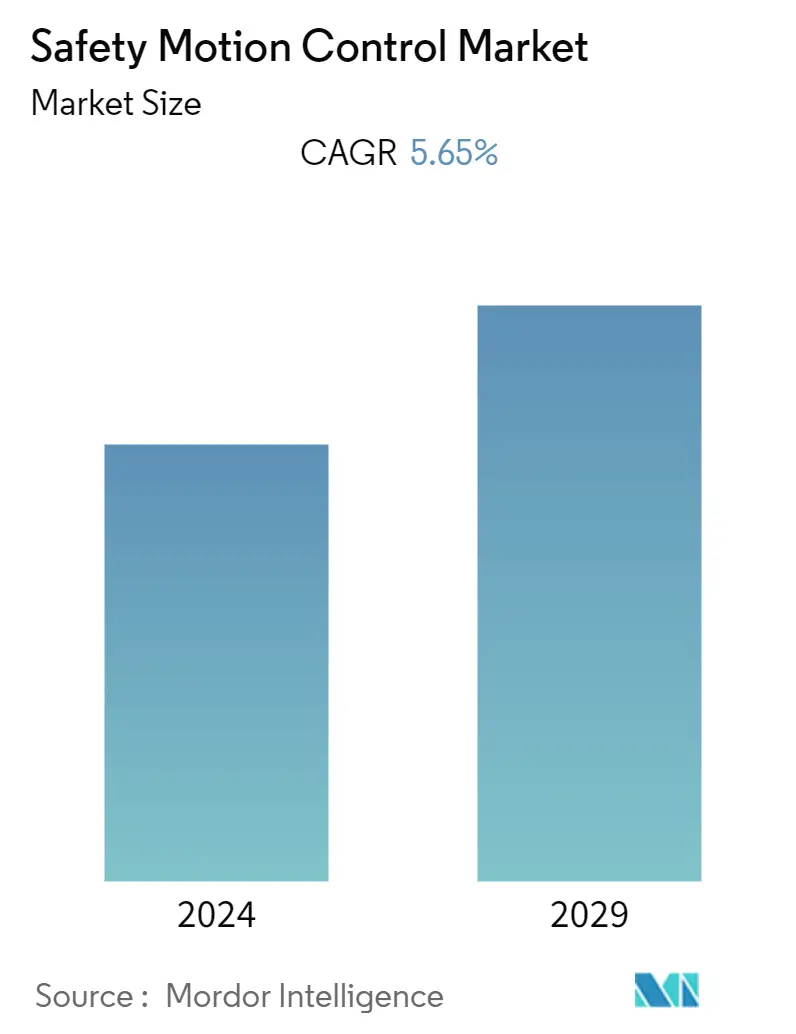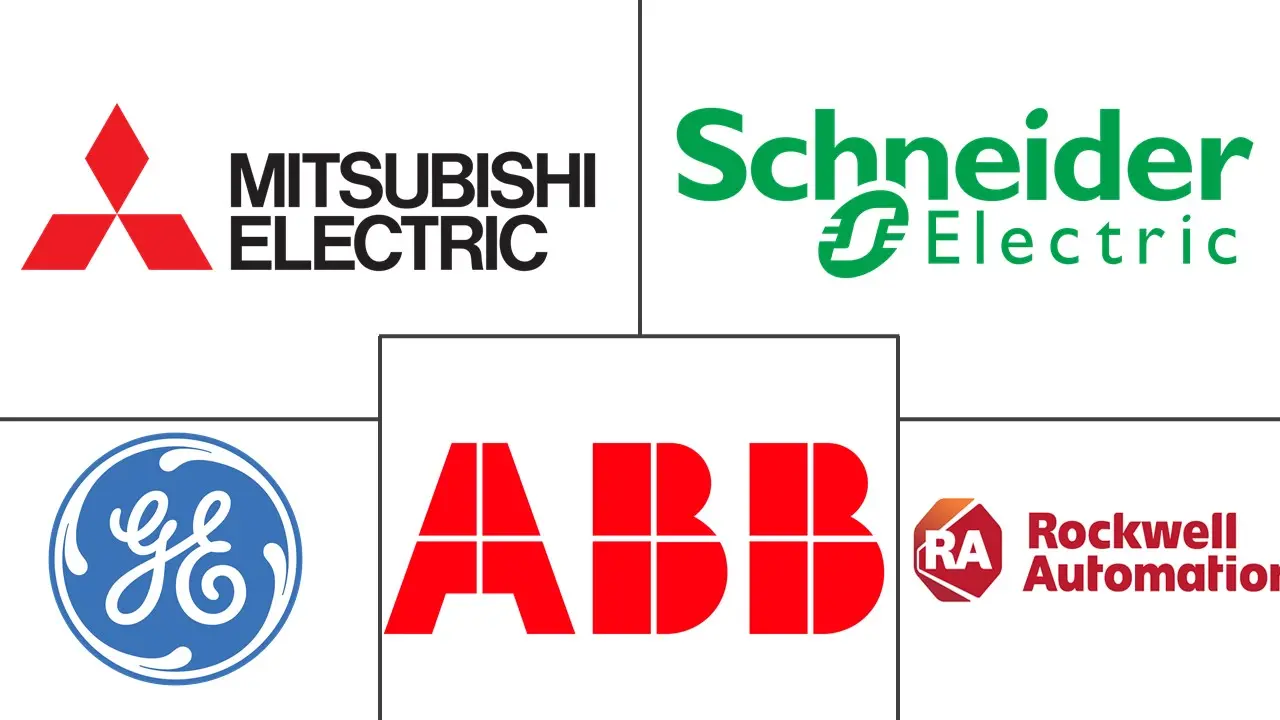
| Study Period | 2019 - 2029 |
| Base Year For Estimation | 2023 |
| Forecast Data Period | 2024 - 2029 |
| CAGR | 5.65 % |
| Fastest Growing Market | Asia Pacific |
| Largest Market | North America |
| Market Concentration | Low |
Major Players
*Disclaimer: Major Players sorted in no particular order |
Safety Motion Control Market Analysis
The safety motion control market was valued at USD 14.85 billion in 2020 and is expected to reach USD 21.99 billion by 2026, at a CAGR of 5.65% over the forecast period (2021 - 2026). The growing trend of automation, increasing adoption of digital technologies, and stringent government regulation regarding industry safety are some of the major factors driving the investment in the safety motion control market.
- Major motion control products for automation solutions are motion controllers, drives, motors, and robotics. Motion control systems are being used to automate processes, and more companies are turning to robotics and conveyor systems to achieve higher efficiency margins in assembly and production. Therefore, various motors are used in these applications to control the process.
- The ongoing trend in industrial automation and rules and regulations regarding energy reserves demands more safety motion control products. Vendors witnessed increasing investments in this arena via multiple product launches, acquiring IIoT software-based companies, and collaborations.
- The increasing adoption of Industrial IoT(IIoT) and the growing number of smart factories are further expanding the growth of the market studied. Smart factories are becoming a significant adopter of safety motion control products, as safety products are the principal architect of smart factories. Besides, the industrial IoT further increased the need and demand for connected machines in the industries. These connected machines alone are not enough to accomplish pure digital transformation; hence, organizations are developing a seamless ecosystem of humans and machines, performing optimized, end-to-end processes.
- Additionally, The increasing trend of warehouse automation and growth in trends, such as digital twin, edge computing, and predictive manufacturing, is also developing space for advanced safety motion control devices. Robots have become a major automation trend across the world. In advanced automotive manufacturing, robots have become a major component. Companies, like Amazon, are also heavily increasing, and robots, like collaborative robots, and AGVs are also becoming the center of attraction in the manufacturing industry.
- COVID-19 pandemic has created an economic turmoil for small, medium, and large-scale industries worldwide. Additionally, the country-wise lockdown has further hit many manufacturing industries. This has fluctuated the demand for safety motion control devices across some sectors. However, the impact of the COVID-19 crisis forced the businesses to adhere to strict requirements to ensure the ongoing safety of their employees and their machines. As a result, the need for automation witnessed a sudden spike.
Safety Motion Control Industry Segmentation
A safety motion controller contains motion profiles and target positions that create trajectories for motors and actuators. Motion control drives are a structural part of motion controllers. These are mainly used for process automation in various end-user industries, such as electronics and assembly, robotics, semiconductors, and food and beverages. Due to the advancement in processing speed, precision, and reliability of these systems, the controllers are widely used in the industries.
| Drives |
| Motors |
| Other Components |
| Automotive |
| Energy and Power |
| Oil and Gas |
| Aerospace and Defense |
| Food and Beverage |
| Pharmaceuticals |
| Other End-user Industries |
| North America | United States |
| Canada | |
| Europe | United Kingdom |
| Germany | |
| France | |
| Rest of Europe | |
| Asia Pacific | China |
| India | |
| Japan | |
| Rest of Asia Pacific | |
| Latin America | Brazil |
| Mexico | |
| Rest of Latin America | |
| Middle East and Africa | United Arab Emirates |
| Saudi Arabia | |
| South Africa | |
| Rest of Middle East and Africa |
Safety Motion Control Market Size Summary
The safety motion control market is experiencing significant growth, driven by the increasing trend of automation and the adoption of digital technologies across various industries. This market is characterized by the use of motion controllers, drives, motors, and robotics to enhance efficiency in processes such as assembly and production. The demand for safety motion control systems is further bolstered by stringent government regulations regarding industry safety and the rise of smart factories, which rely heavily on these systems for optimal operation. The integration of Industrial IoT and advancements in technologies like digital twin, edge computing, and predictive manufacturing are also contributing to the market's expansion. Despite challenges posed by the COVID-19 pandemic, which temporarily disrupted demand in some sectors, the need for automation and safety solutions has seen a resurgence as businesses strive to ensure employee and machine safety.
The automotive industry is a significant contributor to the demand for safety motion control systems, with these systems being extensively used in the manufacturing and assembly processes of vehicles. High-end motion controllers play a crucial role in optimizing production chains, and their adoption is expected to rise with the increasing production of automobiles. The Asia-Pacific region is emerging as a key market due to its manufacturing hub status and the growing adoption of automation. Initiatives like Industry 4.0 and 'Made in China 2025' are further propelling market growth in this region. The market is highly fragmented, with numerous players engaging in strategic mergers, acquisitions, and partnerships to enhance their market share. Key players include Rockwell Automation Inc., ABB Ltd, Schneider Electric SE, Mitsubishi Electric Corporation, General Electric Co., and Siemens AG, who are continuously innovating to meet the evolving demands of the market.
Safety Motion Control Market Size - Table of Contents
1. MARKET DYNAMICS
- 1.1 Market Overview
- 1.2 Industry Value Chain Analysis
-
1.3 Industry Attractiveness - Porter's Five Force Analysis
- 1.3.1 Bargaining Power of Suppliers
- 1.3.2 Bargaining Power of Buyers
- 1.3.3 Threat of New Entrants
- 1.3.4 Intensity of Competitive Rivalry
- 1.3.5 Threat of Substitutes
- 1.4 Assessment of the Impact of COVID -19 on the Industry
-
1.5 Market Drivers
- 1.5.1 Stringent Regulation Regarding Safety
- 1.5.2 Increasing Automation and Increasing Investment in Advance Automation Tool
-
1.6 Market Restraints
- 1.6.1 Installation Costs and Data Security Concern
2. MARKET SEGMENTATION
-
2.1 Component
- 2.1.1 Drives
- 2.1.2 Motors
- 2.1.3 Other Components
-
2.2 End-user Industry
- 2.2.1 Automotive
- 2.2.2 Energy and Power
- 2.2.3 Oil and Gas
- 2.2.4 Aerospace and Defense
- 2.2.5 Food and Beverage
- 2.2.6 Pharmaceuticals
- 2.2.7 Other End-user Industries
-
2.3 Geography
- 2.3.1 North America
- 2.3.1.1 United States
- 2.3.1.2 Canada
- 2.3.2 Europe
- 2.3.2.1 United Kingdom
- 2.3.2.2 Germany
- 2.3.2.3 France
- 2.3.2.4 Rest of Europe
- 2.3.3 Asia Pacific
- 2.3.3.1 China
- 2.3.3.2 India
- 2.3.3.3 Japan
- 2.3.3.4 Rest of Asia Pacific
- 2.3.4 Latin America
- 2.3.4.1 Brazil
- 2.3.4.2 Mexico
- 2.3.4.3 Rest of Latin America
- 2.3.5 Middle East and Africa
- 2.3.5.1 United Arab Emirates
- 2.3.5.2 Saudi Arabia
- 2.3.5.3 South Africa
- 2.3.5.4 Rest of Middle East and Africa
Safety Motion Control Market Research FAQs
What is the current Safety Motion Control Market size?
The Safety Motion Control Market is projected to register a CAGR of 5.65% during the forecast period (2024-2029)
Who are the key players in Safety Motion Control Market?
Rockwell Automation Inc., ABB Ltd, Schneider Electric SE, Mitsubishi Electric Corporation and General Electric Co. are the major companies operating in the Safety Motion Control Market.


